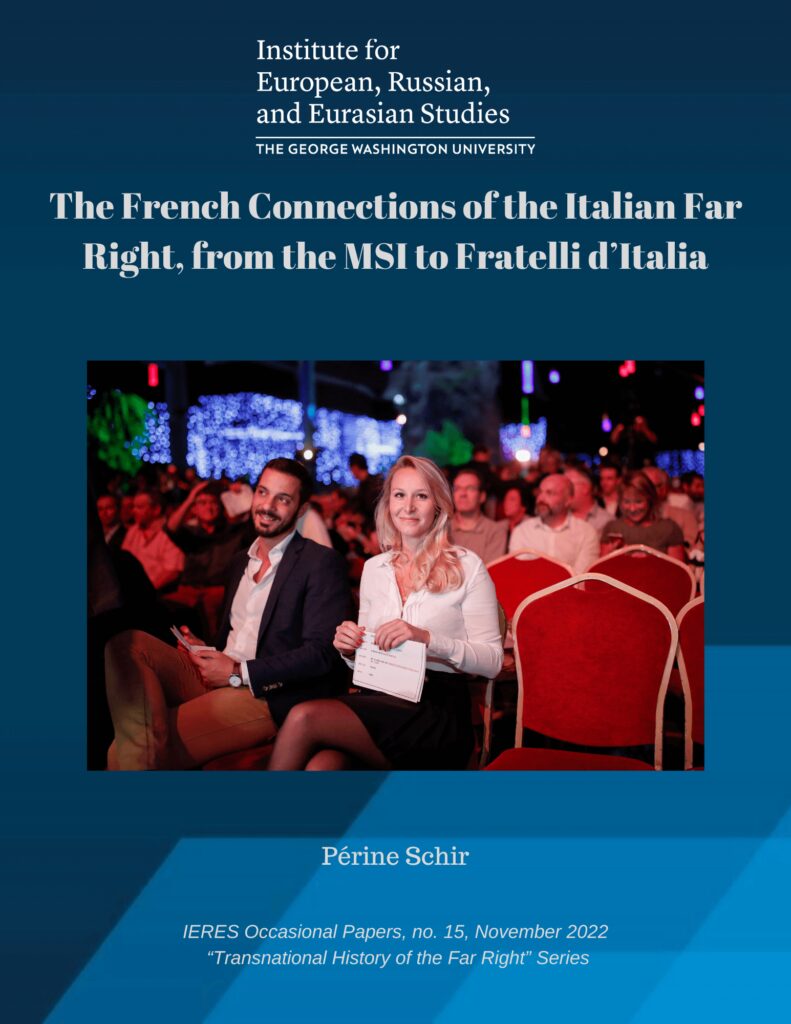
The French Connections of the Italian Far Right, from the MSI to Fratelli d’Italia
Périne Schir
IERES Occasional Papers, no. 15, November 2022 ”Transnational History of the Far Right” Series
Photo: Benoit Tessier, REUTERS / Alamy Stock Photo
The contents of articles published are the sole responsibility of the author(s). The Institute for European, Russian, and Eurasian Studies, including its staff and faculty, is not responsible for any inaccurate or incorrect statement expressed in the published papers. Articles do not necessarily represent the views of the Institute for European, Russia, and Eurasian Studies or any members of its projects.
©IERES 2022
Historically, power was consolidated through marriages between powerful families. The wedding of Fratelli d’Italia MEP Vincenzo Sofo and Marion Maréchal—granddaughter of Front National founder Jean Marie Le Pen—in September 2021 seems symptomatic of a similar determination to unite the forces of the European extreme right. Locally, they already represent a threat to individual freedom and democracy, but international synergies might magnify these local capacities. Indeed, Sofo’s role in the European Parliament, since being elected an MEP in 2019, indicates an effort to target international policies. Instead of trying to leave the European Union in a Brexit-like manner, national extreme right groups, like Meloni’s Fratelli d’Italia seem to have changed course and now aim to take over the EU.
Fratelli d’Italia (FdI) came out on top in the Italian parliamentary elections on September 25, 2022 (with 26.3% of the vote, according to partial results), and its leader, Georgia Meloni, has claimed the leadership of the new government. The coalition the party will form with the other far-right party, Matteo Salvini’s Lega (8.9%), and Silvio Berlusconi’s conservative party Forza Italia (8%) garnered about 44% of the vote, giving it an absolute majority of seats in both the Chamber of Deputies and the Senate.
The leader of the French Rassemblement National (RN), Marine Le Pen, and her number two, Jordan Bardella, both congratulated Meloni on her victory and hailed “the people of Europe,” who are “taking their destiny back into their own hands.”[1] The leader of the new Reconquête party, Eric Zemmour, was optimistic about what the far right’s victory on the other side of the Alps could mean for the future of his own party: “How can we not look at this victory as proof that, yes, coming to power is possible?”[2]
If the French extreme right has followed the Italian election very closely, it is because the FdI’s ancestor, the Movimento Sociale Italiano (MSI) (1946-1995), has long been a privileged political partner and mentor. We will review here the main stages of this Franco-Italian cooperation, in particular the collaboration of the French terrorists with their Italian counterpart in the late 1960s and the role of the MSI as a role model for the Front National[3] (FN) in the mid-1970s. If the FN has gradually detached itself from the MSI and its successors—notably under the impetus of Marine Le Pen, who expressed support instead for Matteo Salvini’s Lega—the torch of this post-fascist Franco-Italian fraternization seems to have recently been taken up by Le Pen’s niece Marion Maréchal, herald of the French radical extreme right and wife of an executive member of the FdI, Vincenzo Sofo.
MSI, OAS, and Ordre Nouveau
Evidence of the connections between the MSI and the Front National can be found in the individual trajectories of their respective founders going back to the Second World War. On the Italian side, the MSI was created by former members of the Salò republic (1943 to 1945), the puppet state established by Mussolini.[4] From its foundation, the Salò republic had connections with the French extreme right, notably Jacques Doriot’s Parti Populaire Français (PPF), the main fascist-inspired party in France, established in 1936. Following the Nazi occupation of France and the imposition of the Vichy regime in 1940, the PPF became the main collaborationist party. In 1941, Doriot helped create the Legion of French Volunteers (LVF), who fought alongside the Wehrmacht on the Eastern front and were later integrated into the Charlemagne SS Division. The secretary general of the PPF, Victor Barthélémy, who also participated in the creation of the LVF, became, in 1944, the representative of the PPF to the Salò Republic. Interestingly enough, Barthélémy would, in 1972, become one of the co-founders of the Front National.
In 1946, the MSI brought together a multitude of groups, movements, and parties created after World War II, all of which claimed to be more or less explicitly fascist. The MSI co-existed on the extreme right with a galaxy of radical groups, of which Pino Rauti’s Ordine Nuovo and Stefano Della Chiaie’s Avanguardia Nazionale constituted the real poles of attraction for militants, who did not recognize themselves in the politics of the MSI, which they judged too moderate. Isolated politically, the MSI turned, from the beginning of the 1950s, to the extreme right in Europe to try to create a “black international.” The latter pursued several projects, including the European Social Movement (1951), the leadership of which included Maurice Bardèche, the brother-in-law of Robert Brasillach, the editor of the French antisemitic newspaper Je suis partout who was executed for collaborationism with Nazi Germany.
1960s: MSI Support for French OAS Terrorists
A few years later, the Algerian war of independence (1954-1962) and the fight for the defense of colonial “French Algeria” constituted an important conjuncture for Franco-Italian far-right solidarity. The Organisation Armée Secrète(OAS), created in the winter of 1960-61 in Madrid by Jean-Jacques Susini and Pierre Lagaillarde, brought together civilians and members of the military who were opposed to the independence of Algeria and wished to see it remain a French colony. Through their terrorist and propaganda actions, the OAS fought against both the Algerian National Liberation Front (FLN) and the politics of the French head of state, General De Gaulle.
If at first glance the French Algeria struggle seemed to concern only the French far right, the OAS activists in fact benefited from significant support from their Italian counterparts. The MSI was obviously at the forefront of this effort, notably translating French propaganda through its youth organizations[5] and its magazines,[6] thus elevating the fight for French Algeria to the status of a model of nationalist resistance on a European scale and making the OAS into a martyr for the cause. Among the key figures of this collaboration between the MSI and the OAS, Guido Giannettini, a member of a youth organization of the MSI, is particularly noteworthy. He ensured contacts,[7] throughout the short life of the OAS, between the MSI and OAS co-founder Lagaillarde, who had taken refuge in Madrid.
Late 1960s: OAS Support for Italian Terrorists
Once Algerian independence was achieved in 1962, the OAS lost its purpose, but some of its activists, particularly those trained in the handling of explosives and various guerrilla tactics, persevered in exile. Meanwhile, the most radical far-right movements in Italy returned to the strategy of violent destabilization of the state and increased their number of terrorist attacks (stragis) at the end of the 1960s. The OAS veterans saw this as an opportunity to put their guerilla skills to good use and to return the favor to their Italian counterparts.
A key figure of this transalpine collaboration was Yves Guérin-Sérac, a founding member of the OAS. In September 1966 he founded Aginter Press, an international anti-communist mercenary organization disguised as a pseudo-press agency that provided a front for the organizing efforts of former Nazi SS operative Otto Skorzeny and his post-war ally and former Belgian SS officer Leon Degrelle, both of whom were operating out of Spain and Portugal. The goal of this organization was to set up training camps to instruct mercenaries and terrorists in covert action techniques, including hands-on bomb terrorism, silent assassination, subversion techniques, clandestine communication, and infiltration and colonial warfare. Aginter Press trained numerous Italian neo-fascist groups in the use of explosives, among them members of Rauti’s Ordine Nuovo and Delle Chiaie’s Avanguardia Nazionale, who were implicated in the 1969 Piazza Fontana Bombing.[8] Aginter Press founder Guérin-Sérac also participated in the bombing,[9] alongside former OAS Italian liaison officer Giannettini, who had been an MSI member since 1965.[10] It is clear that the relations between the French OAS and the Italians of the MSI and the neo-fascist groups that gravitated around it endured for a long time.
But these relations of mutual assistance would extend even further: following the wave of terrorist stragis perpetrated by the Italian extreme right, many members of these organizations became the subject of international arrest warrants that forced them to flee abroad. One of the countries selected as a destination was France,[11] firstly because there was no extradition agreement with Italy at the time, and secondly because the Italian terrorists knew that they would find there a support network ready to help them in their flight.
Such is the case, notably, of Gabriele Adinolfi, a former member of MSI and founder of Terza Positione, a third-positionist neo-fascist movement. Accused of having participated in the 1980 Bologna massacre, he fled to France, where he found shelter with members of the Parti des Forces Nouvelles, a neo-fascist splinter group of the Front National. Over the course of 20 years, Adinolfi participated actively in the dissemination of neo-fascist third-positionism among the French far right. He was also in contact with the Mouvement Nationaliste Révolutionnaire, headed by Jean-Gilles Malliarakis, which, inspired by Adinolfi’s teachings, renamed itself Troisième Voie (Third Way) in 1985. In 2000 Adinolfi returned to Italy after the statute of limitations on the charges against him expired. There, he helped found—and would remain close to—the neo-fascist movement CasaPound. Then, from 2013 onwards, he launched several projects of European scope, notably the think tank EurHope and the association Les Lansquenets. The creation of the latter was announced at a 2017 event organized by Synthèse Nationale, the successor of the Parti des Forces Nouvelles, with which Adinolfi had remained in contact.
Mid-1970s: MSI Support for the French Ordre Nouveau
By the end of the 1960s, the MSI was finding it difficult to play a significant role on the Italian electoral scene. Abroad, however, the MSI had become a role model for the European extreme right, especially the French extreme right, which was in the process of unification. The political line of the MSI and its founder, Almirante, largely inspired the creation of the Front National (FN) as a gathering of a multitude of small far-right groups behind the same “front.” Indeed, Ordre Nouveau, the predecessor of the FN, had established solid bilateral relations with the MSI, which provided it with ideological, propaganda, and financial support.[12] Jean-François Galvaire, the second-in-command of Ordre Nouveau co-founder Alain Robert, was invited to the congress organized by the MSI in November 1969, and gave a speech evoking Jean-Marie Bastien-Thiry, “martyr of the OAS.”[13] Ordre Nouveau co-founder François Duprat—who would go on to found the Front National in 1972—was then invited to Rome in 1971 by MSI founder Almirante.[14] His widow, Assunta Almirante, notably told FN leader Marine Le Pen in 2011: “The Front National was born with Jean-Marie Le Pen and Giorgio Almirante.”[15]
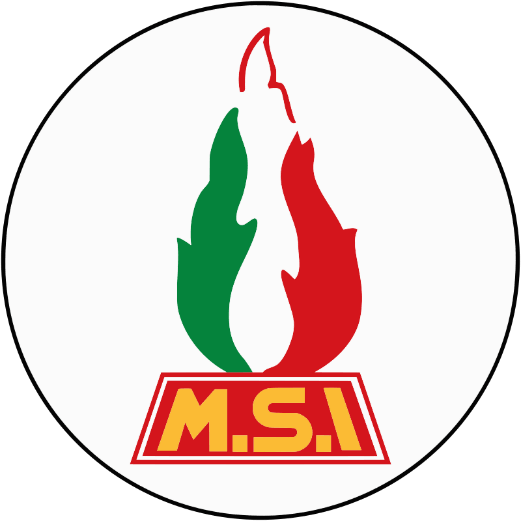
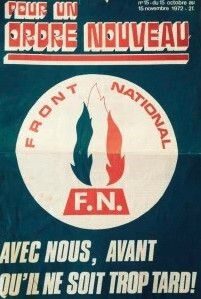
Left: MSI logo from 1947 to 1972; Right: first FN posters in 1972, financed by the MSI
The links between the MSI and the FN were further exemplified by the latter’s adoption of the tricolor flame as its symbol, an appropriation of the Italian party’s heritage that testifies to the ideological and financial ties that unite them. Above all, the flame symbolizes an affiliation with a certain fascist mystique: if officially the acronym MSI stands for “Movimiento Sociale Italiano,” it also has a hidden sense known only to the initiated, namely “Mussolini Sempre Immortale” (Mussolini always immortal), with the base representing Mussolini’s tomb in Predappio and the flames his eternal rebirth.[16]
MSI and FN Both Adopt Mainstream Electoral Strategy
1990s: The Fini/Rauti Split; 2012: Fratelli d’Italia Take Up the Torch of the MSI
On the Italian side, following the MSI’s electoral success in the 1993 municipal elections, Gianfranco Fini, Almirante’s successor, gradually distanced himself from the fascist legacy, transforming the MSI into Alleanza Nazionale (AN)in January 1995. That occasion saw the formation of a splinter group, Movimento Sociale Fiamma Tricolore, led by Rauti, founder of Ordine Nuovo, one of the neo-fascist groups that had been involved in the 1969 Piazza Fontana bombings. Rauti (born in 1926) was one of the original youth members of the MSI and had been seeking to succeed Almirante as leader of the MSI. Whereas Fini sought to distance himself and the party from its fascist heritage, Rauti was looking to honor Mussolini’s, notably by adopting the classic post-fascist “third position” ideology. If Rauti’s party still exists today, it has been in sharp decline since the death of its founder in 2012 and now counts only a few hundred members. Rauti’s legacy is continued today by his daughter, Isabella Rauti, founder of the “Centro Studi Pino Rauti,”[17] whose name echoes that of her father’s “Centro Studi Ordine Nuovom,” founded in 1956 in parallel with the MSI and influenced by the teachings of Julius Evola. Isabella Rauti is also actively involved in politics, but not in her father’s Fiamma Tricolore: she joined Fratelli d’Italia in 2014, was elected to the senate in 2018, was re-elected in 2022, and is now deputy VP of the senate FdI group.
Fratelli d’Italia seems to be the party that best represents the radical heritage of the MSI today. Indeed, traces of this radical heritage can be found in Georgia Meloni, who, despite having a seemingly moderate résumé—having been a member of Fini’s mainstream Alleanza Nationale and served in Silvio Berlusconi’s cabinet—has still attracted attention for some of her more ambiguous statements, notably her assertion that Mussolini is “the best politician of the last 50 years.”[18] That radical heritage is even clearer in the case of FdI co-founder and Senate speaker Ignazio La Russa. Although he also originates from Fini’s AN, La Russa is 30 years older than Meloni and was long a member of the MSI. He is known for his collection of Mussolini memorabilia,[19] a passion that was presumably passed down to him by his father, who was a local official for Mussolini’s Partito Nazionale Fascista and then senator for its successor organization, the MSI, set up by Mussolini’s followers.[20]
1980s-90s: First Electoral Success of the FN and Its “Dediabolization” Strategy
On the French side, the first electoral successes of the Front National in 1983-1984 gradually enabled it to escape from the shadow of the MSI. In the European elections of 1984, FN founder Jean-Marie Le Pen obtained 10.95% of the vote and, consequently, ten elected MEPs and a substantial financial contribution. Le Pen could not yet, however, do without the support of his transalpine counterpart, Almirante, whom he met regularly between 1984 and 1988.
Things changed in the 1990s: when Almirante was replaced with Fini, Le Pen lost a lifelong collaborator. The FN itself was also changing, notably with the advancement of Bruno Mégret as Le Pen’s number two. Mégret pushed Le Pen toward a strategy of mainstreamization and conquest of power—nicknamed “dediabolization” by FN executives and the French media[21]—that required the party to distance itself from all the overly radical aspects of its identity, most notably its link with the MSI. There would therefore be no further contact between the MSI and the FN for about 20 years, or until the election of Jean-Marie Le Pen’s daughter, Marine Le Pen, as president of the party in January 2011. Indeed, in October 2011, a few months after taking over from her father, Marine Le Pen met Assunta Almirante, widow of MSI founder Giorgio Almirante. The meeting, which took place in Italy, was organized by Frédéric Chatillon, a close adviser to Marine Le Pen and former member of the violent student group GUD, which brought together militants of “national-révolutionnaire” and neo-Nazi sensibilities.
After being indicted in the case over illegal financing of the FN, Chatillon moved in 2014 to Italy, where he created several businesses with his friends from the GUD. In addition to an Italian branch of his communications company, Riwal, Chatillon also set up a French restaurant in downtown Rome with Jildaz Mahé O’Chinal, a former GUD colleague. In the process, the two friends reconnected with another acquaintance in Rome, Sébastien Manificat, French spokesman for the neo-fascist organization CasaPound. Moreover, the restaurant is domiciled in France, at the address of a company directed by Philippe Péninque. Péninque, Chatillon, and Mahé O’Chinal have a long history of working together: they each led the GUD at different times and retain strong contacts in Italy from these years. The ideological bridges between the GUD and their Italian counterparts are evident from the creation, in 2017, of Bastion Social, heir of the dissolved GUD, which was largely inspired by the Italian neo-fascists of CasaPound.
After her initial contact with the widow of MSI founder Almirante, Marine Le Pen developed friendly relations with the heir of MSI, Fratelli d’Italia, and especially its co-founder Meloni. In January 2015, Meloni invited Le Pen to be the guest of honor on the political talk show “Dimartedi.”[22] In 2017, Meloni also spoke in favor of Le Pen’s candidacy in the presidential elections.[23]
Moreover, Le Pen and Meloni share a common friend: former White House adviser of President Trump and “replacement theory” aficionado Steve Bannon. Indeed, Bannon supported both women’s rise to political stardom. Bannon met Meloni during one of his many visits to European far-right parties in 2018 in the context of building his “Movement.” Meloni and Bannon gave an interview together to The Guardian in November 2018,[24] after which Bannon called Meloni a “rock star,”[25] according to Benjamin Harnwell, international editor of Bannon’s “War Room” podcast. Meloni then participated in the February 2022 iteration of the Conservative Political Action Conference (CPAC), a right-wing conclave organized annually in the US. She is indeed very popular on the other side of the Atlantic: following her victory in September 2022, several members of the Republican Party praised her win, including Senator Ted Cruz (Texas), Senator Tom Cotton (Arkansas) and U.S. representative for Georgia and far-right conspiracy theorist Marjorie Taylor Greene.[26] The news of her victory was also relayed by Fox News host Tucker Carlson, who described it as a “revolution.”[27] On the French side, Le Pen met Bannon during his 2018 European tour. Le Pen then invited him to the FN congress in Lille in March 2018, where Bannon gave a speech in which he invited Le Pen to wear the term “racist” as a “badge of honor.”[28] They saw each other again in December 2018, having both been invited to Brussels by the extreme right-wing party Vlaams Belang to denounce the alleged “global pact for regular migration”[29] put forward by the United Nations. Bannon traveled to Paris again a few months later, in May 2019, to support the Rassemblement National’s campaign for the European elections.[30]
Since 2017, however, there has been radio silence between Meloni and Le Pen. When asked about the lack of collaboration between the two, several RN MEPs affirm that relations with their Italian colleagues are “warm,” while acknowledging that”no one has ever been mandated” to “build bridges officially with Fratelli d’Italia.”[31]Indeed, in the run-up to the 2019 European elections, Le Pen ultimately decided to bet on another horse: Salvini’s Lega. Le Pen never showed any hostility toward FdI, but made a purely strategic choice to ally with the influential Salvini—who was Minister of the Interior in 2018—rather than Meloni, whose political weight was at the time much more marginal. The instrument she chose for this rapprochement with Salvini was none other than her niece, Marion Maréchal. A member of FN since 2008 and elected an MP in the 2012 legislative elections, Maréchal is very popular with the far-right crowd, in France and abroad, because she represents the traditionalist and Catholic far right that was dear to her grandfather, FN founder Jean-Marie Le Pen, and that her aunt has abandoned in favor of a more “modern” narrative. This popularity was put to good use by Marine Le Pen, who used her for a while as an FN special envoy in Italy.
Maréchal attended her first Lega Nord meeting in Rome on March 15, 2016. At this meeting, she met Salvini in person for the first time.[32] As usual, that meeting was facilitated by Philippe Vardon, a former GUD member who is close to Marine Le Pen, is a friend of Chatillon, and once served as the leader of the Bloc Identitaire. Once the doors to collaboration with the Lega had been opened, Maréchal multiplied her trips to Italy.
Vincenzo Sofo: Fratelli d’Italia’s French Connection?
2016-2021: When Vincenzo Met Marion
These Italian visits would also allow Maréchal to maintain contact with her future husband, Vincenzo Sofo. A member of Lega since 2009, he created in 2010 “Il Talebano,” a think tank and political discussion website whose proposals were regularly repeated and adopted by the head of the Lega, Salvini. Sofo therefore contributed actively to the change in the party line from an essentially regionalist program to a full-on nationalist position.[33] This ideological change was officially ratified at the “Toward a National Lega” conference that took place in Rome on April 21, 2015, in which Sofo participated alongside other major figures of the European extreme right, including theoretician of the neo-Eurasianist movement Alexander Dugin. Following their initial meeting in March 2016,[34] Sofo invited Maréchal to be the guest of honor at a meeting co-organized by Sofo’s think tank “Mille Patrie,” Lega Nord,and Fratelli d’Italia that took place on November 25, 2016, in Florence. In time, the pair developed a romantic relationship that was the subject of an article in the Italian celebrity press in 2018[35] and led to their marriage in 2021.
Between 2016 and 2021, their respective careers have undergone important changes, some of them in a very close temporality, proof both of the porosity of their political project and of their willingness to evolve in the same direction. In 2017, Maréchal left the FN and began her short “political retirement,” devoting herself for a few years to a far-right “finishing school” aimed at educating the nationalist leaders of tomorrow—the results of which were mediocre and from which she ended up detaching herself in 2021. In the meantime, if Maréchal refuses to affiliate herself with or to support her aunt’s party, this has not meant that she has ceased to be involved in politics altogether. In fact, in 2018 she was invited to the Conservative Political Action Conference (CPAC), where she spoke alongside Donald Trump. In 2020 Maréchal was invited to speak at the National Conservatism Conference, this time alongside Salvini, Meloni, and Viktor Orbán. Even though she was not a member of any political party at the time, she continued to build her network with the European and transatlantic far-right.
2019: Sofo and Maréchal at the Illiade Institute; Dominique Venner’s Legacy in Italy
Meanwhile, Sofo was trying to gain a foothold in the Lega, and in 2019 he ran for MEP in the European elections. Maréchal accompanied Sofo during his campaign tour[36] to help him benefit from her popularity—which resulted in the Italian media nicknaming Sofo “Monsieur Le Pen.”[37] Sofo’s electoral campaign even brought them to France, where they participated together, on April 6, 2019, in the annual symposium of the Iliade Institute.[38] Established in 2013, the Iliade Institute was founded by friends of the late Dominique Venner—the ideologue of the French Nouvelle Droite—to share his teachings. Venner was, along with Alain de Benoist, one of the main intellectual figures of the Groupement de recherche et d’études pour la civilisation européenne (GRECE), the ideological laboratory of the Nouvelle Droite.
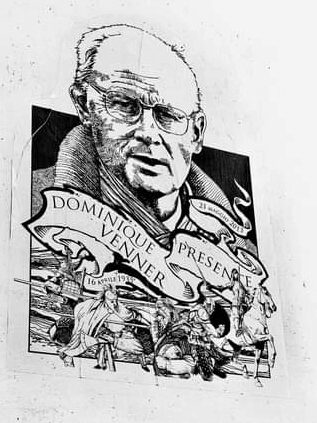

Left: A poster honoring Dominique Venner posted on the Azione Studentesca Facebook page on May 20, 2022, to commemorate the ninth anniversary of his suicide, which took place on May 21, 2013.[39]
Right: The poster for an event organized by Azione Studentesca on July 22-24, 2022, displaying the identitarian lambda symbol on a Spartan shield.[40]
Sofo was invited to the 2019 annual conference of GRECE’s successor because the Nouvelle Droite, and the figure of Venner in particular, has had a strong ideological impact on the Italian extreme right. In May 2013, Venner committed suicide in the cathedral of Notre-Dame de Paris to protest “against the crime aimed at the replacement of our populations.”[41] When the news spread to Italy, banners appeared on the walls of about fifty Italian cities displaying the logo of Casa Pound and the following sentence: “Onore a Dominique Venner, Samurai d’Occidente” (Honoring Dominique Venner, Samurai of Occident).[42]
Venner’s individual trajectory embodies the evolution of the Franco-Italian far-right collaboration we have described: a paratrooper in the Algerian conflict, he was imprisoned between July 1961 and September 1963 for his involvement with the OAS. Back in France, Venner was an activist in Jeune nation, the predecessor of Ordre Nouveau and the Front National.
Venner’s popularity among the Italian far right is also expressed by Azione Studentesca, the student movement of Alleanza Nazionale—the successor to MSI, led by Fini—of which FdI leader Meloni was the national leader from 1996 to 2009. Azione Studentesca honored Venner’s memory by posting a portrait of him on its Facebook page on May 20, 2022, to commemorate the ninth anniversary of his suicide, which took place on May 21, 2013. Historically, Azione Studentesca used the same logo as GRECE, a stylized variant of the Celtic cross, already used notably by Front National predecessor Ordre Nouveau. Recently, however, the have been using the lambda symbol, inspired by the Spartan shields popularized by the Identitarian movement. The European-wide Identitarian movement originated in the French Bloc Identitaire, formed by former members of the GUD and led by Vardon. Renamed several times—becoming Jeunesse Identitaire and then Génération Identitaire—this group was officially dissolved by the French government in 2021. However, its local structures continue to function under other names, and the movement continues to gain traction in the rest of Europe, notably in Italy, where Azione Studentesca borrowed their logo for an event in July 2022. Its tentacles have carried the Identitarian movement as far as the United States, where Identitarian flags were spotted at the White supremacist rally organized on August 11-12, 2017, in Charlottesville.[43] Meanwhile, the leader of the Austrian Identitarian Movement, Martin Sellner, also allegedly received a €1,500 donation from the Christchurch attacker.[44]
The connection between the Nouvelle Droite and the Italian far right is not limited to Venner. In 2017, a publishing house called Passaggio al Bosco opened shops in Florence inside an Identitarian clubhouse called Casaggi Spazio Identitario. At that clubhouse, on June 11, 2022, an event co-organized by Passaggio al Bosco and the Iliade Institute took place that included Claude Challot, who had been president of GRECE in 1984.[45] In addition, the aforementioned “Centro Studi Pino Rauti” created by Isabella Rauti to honor the memory of her father, Pino Rauti, a founding member of MSI, uses the same logo as GRECE did in the 1960s.

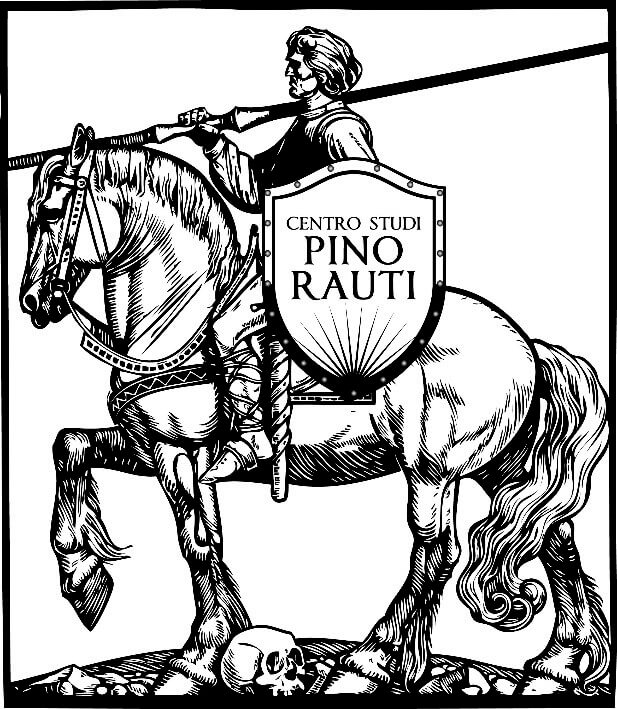
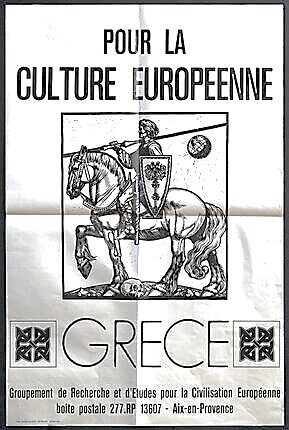
Top left: logo of Azione Studentesca. Bottom left: logo of the Centro Studi Pino Rauti. Right: logo of GRECE in the 1960s.
These youth groups, with their few thousand members throughout Europe, may seem marginal compared to the 12 million votes obtained by the right-wing coalition led by Meloni in September 2022 in Italy. However, it is important to keep in mind that the youth groups are a way for these parties, which aim to conquer power, to keep their radical elements away from the eyes of the public and the media. If youth groups and the national party remain separate entities, the two nevertheless maintain a very close relationship, as demonstrated by the ties between Marine Le Pen and the former leaders of GUD, notably Vardon and Chatillon, who are today among her most esteemed advisors.[46]
2021-2022: Sofo Leaves Lega for Fratelli d’Italia; Maréchal Joins Zemmour’s Reconquête
In May 2019, Sofo was elected as a Lega MEP. He joined the Identity and Democracy (ID) group in the European Parliament, in which both the Lega and the FN MEPs sit. Not two years after his election, however, Sofo changed sides: on February 18, 2021, to express his strong dissent from Salvini’s choice to join the Draghi government,[47] Sofo left the Lega and joined Meloni’s Fratelli d’Italia, thereby switching to the European Conservatives and Reformists (ECR) group.
By jumping ship, what Sofo seemed to be expressing was that “mainstreamized” nationalist parties, such as the Lega and FN, do not constitute a viable option in the long run. With Meloni’s victory, a new wave of far-right parties that embrace radical and reactionary ideas, such as FdI, seem to be gaining momentum. It is perhaps precisely this that Maréchal was seeking when she joined Éric Zemmour’s new Reconquête party. Even before she officially joined, Maréchal had already been pulling strings in the background, putting her connections with the European extreme right at the service of Zemmour. She notably had Zemmour invited to Budapest in September 2021, where he met with Orbán’s Minister for Family Affairs, Katalin Novák. Even if Zemmour’s party did not succeed in the presidential or legislative elections, Maréchal intends to try again in 2027, and is already working with the other VPs of the party to find a solution to the most urgent problem: how to keep Reconquête alive politically for the next five years.[48]
The recent career choices of the Maréchal-Sofo power couple seem ultimately to be the symptom of a broader restructuring of the European far right. First, of the emergence of a new generation of national far-right parties, breaking away from their predecessors by taking an unapologetic stance and embracing their most radical heritage, as indicated by Meloni’s victory in Italy and the breakthrough of the newcomer Zemmour on the French political scene. But it is also worth noting the shift being undertaken as we speak by the “old school” far-right parties towards parliamentary politics, notably the recent resignation of Marine Le Pen from the presidency of her party to concentrate on the management of the RN parliamentary group in the French National Assembly. It remains to be seen what bridges will be created by the new generation, notably between Meloni and the new leader of the RN, 27-year-old Jordan Bardella.
[1] Jordan Bardella, Twitter post, September 25, 2022, 11:41 p.m., https://twitter.com/J_Bardella/status/1574152078842281986.
[2] Eric Zemmour, Twitter post, September 25, 2022, 11:51 p.m., https://twitter.com/ZemmourEric/status/1574154574050607110.
[3] Renamed Rassemblement National in 2018.
[4] A number of historians suspect some connections between the Italian and French far rights even before the Second World War, notably Benito Mussolini’s support for the February 6, 1934, far-right attempted coup d’état in France. Sufficient proof of this, however, has yet to be discovered. See Serge Bernstein, Le 6 février 1934 (Paris: Gallimard, 1975).
[5] Pauline Picco, Liaisons dangereuses. Les extrêmes droites en France et en Italie (1960-1984) (Rennes: Presses Universitaires de Rennes, 2018), 53-57.
[6] Ibid., 61-63.
[7] Frédéric Laurent, L’orchestre noir, Enquête sur les réseaux néo-fascistes (Paris: Nouveau Monde Editions, 2016), 100, fn. 70.
[8] Daniele Ganser, NATO’s Secret Armies: Operation GLADIO and Terrorism in Western Europe (London: Routledge, 2005), 120.
[9] Laurent, L’orchestre noir, 15. The Italian secret services accused Guérin Sérac of being the “brain” of the operation.
[10] Ibid., 189-192.
[11] Picco, Liaisons dangereuses, 165.
[12] Ibid., 234.
[13] Ibid., 216.
[14] Ibid., 230.
[15] Valérie Igounet and Pauline Picco, “Histoire du logo de deux ‘partis frères’ entre France et Italie (1972-2016),” Histoire@Politique 29, no. 2 (2016): 220-235.
[16] Ibid.
[17] “Statuto del Centro Studi Pino Rauti,” Centro Studi Pino Rauti, accessed October 26, 2022, http://pinorauti.org/centro-studi-pino-rauti/.
[18] “Giorgia Meloni nel 1996 a 19 anni: ‘Mussolini è stato un buon politico, il migliore degli ultimi 50 anni,’” La Stampa, August 16, 2022, https://www.lastampa.it/speciale/politica/elezioni-politiche-2022/2022/08/16/video/giorgia_meloni_nel_1996_a_19_anni_mussolini_e_stato_un_buon_politico_il_migliore_degli_ultimi_50_anni-6583305/.
[19] Vanessa Ricciardi, “Le nostalgie fasciste di Ignazio La Russa, il nuovo presidente del Senato,” Domani, October 11, 2022, https://www.editorialedomani.it/politica/italia/le-nostalgie-fasciste-di-ignazio-la-russa-possibile-futuro-presidente-del-senato-video-olitgvpo.
[20] “Far-Right Veteran Elected Italian Senate Speaker,” France24, October 13, 2022, https://www.france24.com/en/live-news/20221013-far-right-veteran-elected-italian-senate-speaker.
[21] Alexandre Dézé, “La “dédiabolisation”. Une nouvelle stratégie?” in Les Faux-semblants du Front national: sociologie d’un parti politique (Paris: Presses de Sciences Po, 2015), 27-50.
[22] “L’intervista a Marine Le Pen,” Dimartedi, last modified January 20, 2015, https://www.la7.it/dimartedi/video/lintervista-a-marine-le-pen-20-01-2015-145400.
[23] Franco Bianchini, “Meloni: ‘Io sto con la Le Pen, è l’unica che combatte inciuci e ammucchiate,’” Secolo D’Italia, April 24, 2017, https://www.secoloditalia.it/2017/04/meloni-io-sto-con-la-le-pen-e-lunica-che-combatte-inciuci-e-ammucchiate/.
[24] Paul Lewis and Jennifer Rankin, “Steve Bannon’s Far-Right Europe Operation Undermined by Election Laws,” The Guardian, November 21, 2018, https://www.theguardian.com/world/2018/nov/21/steve-bannons-rightwing-europe-operation-undermined-by-election-laws.
[25] Melissa Rossi, “A Century after Mussolini Seized Power, Giorgia Meloni Looks to Steer Italy Back toward Nationalism,” Yahoo News, September 12, 2022, https://www.yahoo.com/news/a-century-after-mussolini-seized-power-giorgia-meloni-looks-to-steer-italy-back-toward-nationalism-183116834.html.
[26] Amanda James, “Giorgia Meloni and the Friends That Love Her: Bannon, Carlson and Taylor Greene,” La Voce Di New York, September 28, 2022, https://lavocedinewyork.com/en/news/2022/09/28/giorgia-meloni-and-the-friends-that-love-her-bannon-carlson-and-taylor-greene/.
[27] Tucker Carlson, “TUCKER CARLSON: We Live in a Fake Democracy—and There Will Be a Revolution Like Italy,” Fox News, September 26, 2022, https://www.foxnews.com/opinion/tucker-carlson-live-fake-democracy-revolution-like-italy.
[28] Tracy McNicoll, “Wear ‘Racist’ Like a Badge of Honour, Bannon Tells French Far-Right Summit,” France 24, March 11, 2018, https://www.france24.com/en/20180311-france-usa-bannon-le-pen-national-front-racist-badge-honour-populist-pep-talk-lille-trump.
[29] Jean Quatremer, “Steve Bannon et Marine Le Pen font cause commune à Bruxelles,” Libération, December 9, 2018, https://www.liberation.fr/planete/2018/12/09/steve-bannon-et-marine-le-pen-font-cause-commune-a-bruxelles_1696971/.
[30] “Steve Bannon à Paris pour soutenir Marine Le Pen : des représentants de la LRM s’indignent,” Le Monde, May 18, 2019, https://www.lemonde.fr/politique/article/2019/05/18/steve-bannon-a-paris-pour-soutenir-marine-le-pen-des-representants-de-la-lrm-s-indignent_5463947_823448.html.
[31] Lucas Burel, “Entre Marine Le Pen et Giorgia Meloni, ce n’est pas la dolce vita. Voici pourquoi,” Nouvel Obs, October 1, 2022, https://www.nouvelobs.com/politique/20221001.OBS63946/entre-marine-le-pen-et-giorgia-meloni-ce-n-est-pas-la-dolce-vita-voici-pourquoi.html.
[32] Dominique Albertini, “Maréchal-Le Pen fait bande à part à Milan,” Libération, March 17, 2016, https://www.liberation.fr/france/2016/03/17/marechal-le-pen-fait-bande-a-part-a-milan_1440386/.
[33] Riccardo Ferrazza, “Chi è Vincenzo Sofo, il ‘talebano’ che Salvini vuole mandare in Europa,” Il Sole 24 Ore, April 10, 2019, https://www.ilsole24ore.com/art/chi-e-vincenzo-sofo-talebano-che-salvini-vuole-mandare-europa-ABkRKAnB.
[34] Alexandre Sulzer, “‘Ça arrange tout le monde’: Marion Maréchal se marie le jour de la rentrée de Marine Le Pen,” Le Parisien, September 2, 2021, https://www.leparisien.fr/politique/ca-arrange-tout-le-monde-marion-marechal-se-marie-le-jour-de-la-rentree-de-marine-le-pen-02-09-2021-JPAHEECUZBAUBMAKXNKJFY4TM4.php.
[35] “Vincenzo Sofo, chi è il leghista italiano che sta con Marion Le Pen,” Corriere Della Sera, July 17, 2018, https://www.corriere.it/cronache/18_luglio_17/vincenzo-sofo-leghista-che-ha-fatto-perdere-testa-nipote-le-pen-800ef258-89c1-11e8-8bbc-b107b233a106.shtml.
[36] Alexandre Sulzer, “Européennes 2019: Marion Maréchal fait campagne pour son compagnon en Italie,” Le Parisien, May 19, 2019, https://www.leparisien.fr/elections/europeennes/europeennes-2019-marion-marechal-fait-campagne-pour-son-compagnon-en-italie-19-05-2019-8075022.php.
[37] Emanuele Lauria, “Vincenzo Sofo passa a FdI: Meloni scippa alla Lega ‘monsieur Le Pen,’” La Repubblica, June 7, 2021, https://www.repubblica.it/politica/2021/06/07/news/e_meloni_scippa_alla_lega_l_eurodeputato_sofo-304667094/.
[38] “‘Europe : l’heure des frontières’: l’Institut Iliade annonce son colloque pour le 6 avril 2019,” Breizh Info, January 30, 2019, https://www.breizh-info.com/2019/01/30/110875/europe-lheure-des-frontieres-linstitut-iliade-annonce-son-colloque-pour-le-6-avril-2019/; Pierre Plottu and Maxime Macé, “Marion Maréchal sera au colloque des identitaires de l’institut Iliade,” Libération, February 25, 2021, https://www.liberation.fr/politique/marion-marechal-sera-au-colloque-des-identitaires-de-linstitut-iliade-20210225_OC2MFNAUWJHPBCTLX2DWLOULPA/.
[39] Azione Studentesca, Facebook photo, May 20, 2022, https://m.facebook.com/photo.php?fbid=379812517520287&id=100064746247169&set=pb.100064746247169.-2207520000.&eav=AfZmlUpnHYMaV4yAEMlSBF1CIItrNcIZVTpPY8zysgM0To8Axqkjck5hgSHWciH4Am8&paipv=0.
[40] Azione Studentesca, Facebook photo, June 10, 2022, https://m.facebook.com/photo.php?fbid=393921556109383&id=100064746247169&set=pb.100064746247169.-2207520000.&eav=AfYDX3qIsuwks98e0FarUbv1_ve9DcLZXbmxWrZxS2Il-50HF9NgAZVUS3bQrpThKZA&paipv=0&source=42.
[41] Noël Mamère, “Dominique Venner, ‘martyr’ d’un contre-mai 68,” Nouvel Obs, May 27, 2013, https://www.nouvelobs.com/rue89/rue89-noel-toute-lannee/20130527.RUE7854/dominique-venner-martyr-d-un-contre-mai-68.html.
[42] Picco, Liaisons Dangereuses, 257.
[43] “Flags and Other Symbols Used by Far-Right Groups in Charlottesville,” Southern Poverty Law Center, August 12, 2017, https://www.splcenter.org/hatewatch/2017/08/12/flags-and-other-symbols-used-far-right-groups-charlottesville.
[44] Jason Wilson, “With Links to the Christchurch Attacker, What Is the Identitarian Movement?” The Guardian, March 28, 2019, https://www.theguardian.com/world/2019/mar/28/with-links-to-the-christchurch-attacker-what-is-the-identitarian-movement.
[45] Adriano Scianca, “L’Institut Iliade arriva in Italia. Chollet: ‘Costruiamo insieme la nostra Europa,’” Il Primato Nazionale, June 9, 2022, https://www.ilprimatonazionale.it/cultura/linstitut-iliade-arriva-in-italia-chollet-costruiamo-insieme-la-nostra-europa-235836/.
[46] Marine Turchi and Mathilde Mathieu, “La ‘GUD connection’ tient les finances de Marine Le Pen,” Mediapart, October 17, 2013, https://www.mediapart.fr/journal/france/151013/la-gud-connection-tient-les-finances-de-marine-le-pen.
[47] Matteo Pucciarelli, “L’europarlamentare Sofo lascia la Lega: ‘Non posso condividere la grande alleanza di governo’. Verso il gruppo di Meloni,” La Repubblica, February 18, 2021, https://www.repubblica.it/politica/2021/02/18/news/sofo_lascia_lega_dopo_accordo_con_draghi-288132002/.
[48] Paul Laubacher, “Les lieutenants d’Eric Zemmour ont un plan pour exister jusqu’en 2027,” L’Opinion, October 16, 2022, https://www.lopinion.fr/politique/les-lieutenants-deric-zemmour-ont-un-plan-pour-exister-jusquen-2027.







